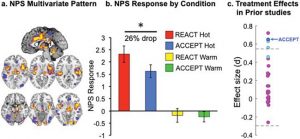Improve Emotion Regulation and Reduce Pain with Mindful Acceptance
By John M. de Castro, Ph.D.
“Individuals with minimal mindfulness meditation experience can quickly learn how to moderate their brains’ responses to painful experiences and negative images using a technique called mindful acceptance’” – Christopher Berglund
There is an accumulating volume of research findings to demonstrate that mind-body therapies have highly beneficial effects on the health and well-being of humans. Mindfulness practices have been shown to improve emotion regulation producing more adaptive and less maladaptive responses to emotions. In other words, mindful people are better able to experience yet control their responses to emotions. The ability of mindfulness training to improve emotion regulation is thought to be the basis for a wide variety of benefits that mindfulness provides to mental health
Indeed, mindfulness practices are effective in treating pain in adults.
We all have to deal with pain. It’s inevitable, but hopefully it’s mild and short lived. For a wide swath of humanity, however, pain is a constant in their lives. Pain involves both physical and psychological issues. The stress, fear, and anxiety produced by pain tends to elicit responses that actually amplify the pain. So, reducing the emotional reactions to pain may be helpful in pain management. Emotional and pain experiences are processed in the nervous system. So, it’s likely that mindfulness practices somehow alters the brain’s processing of emotions and pain.
In today’s Research News article “Let it be: mindful acceptance down-regulates pain and negative emotion.” (See summary below or view the full text of the study at: https://www.ncbi.nlm.nih.gov/pmc/articles/PMC7057281/), Kober and colleagues recruited healthy adults and instructed them to on cue to “react naturally, whatever your response might be” and on another cue to accept. They were instructed for the accept condition to be mindful in the present moment and not judge what is happening but to accept it as it is. They then underwent brain scanning with functional Magnetic Resonance Imaging (fMRI). While in the scanner they were presented with a cue to either react or accept their experience. They were then presented with either neutral or emotionally negative images or a warm or hot thermal stimulus on their forearm. Afterward they rated how negatively they felt.
They found that the participants rated the emotionally negative picture and the hot stimulus as more negative than the neutral pictures or warm stimulus. But after the accept cue they reported lower negative ratings to both the negative images and hot stimulus. Hence, expressing an attitude of mindful acceptance produced lesser negative reactions to negative emotional and thermal stimuli.
The brain activity to the stimuli revealed that during the accept condition there was less activity in the amygdala than during the react condition. The painful, hot, thermal stimulus produced increased brain activity in widespread regions but during the mindful acceptance condition, the activations were significantly lower. Hence, expressing an attitude of mindful acceptance produced less brain activation to negative stimuli.
It should be pointed out that the study design contains considerable demand characteristics. Instructing a participant to take on an attitude of non-judging acceptance cues the participant that less reaction is expected. This demand characteristic may account for the ratings. It is less likely, though, that it could account for differential brain activations. Of course, demand characteristics probably have their effects by altering brain processing of the conditions.
Regardless, these findings are interesting and demonstrate that a brief mindfulness instruction is sufficient to alter the participants’ experiences of and the responses of their brains to neutral and negative experiences. In addition, the instruction appears to be sufficient to alter the experience of and brain activity to painful stimuli. This suggest that the mindful acceptance instruction produced an improved ability to regulate emotional reactions and experiences of pain and the brains responses to these conditions.
It has been repeatedly demonstrated in prior research that mindfulness improves emotion regulation and reduces pain perception. So, the present findings are compatible with prior findings. The contribution of the present study is the demonstration that a brief instruction and training in taking on an attitude of mindful acceptance is sufficient to produce these effects. It remains for future research to determine if this instruction is sufficient to alter real world reactions.
So, improve emotion regulation and reduce pain with mindful acceptance.
“The ability to stay in the moment when experiencing pain or negative emotions suggests there may be clinical benefits to mindfulness practice in chronic conditions as well — even without long meditation practice.” – Hedy Kober
CMCS – Center for Mindfulness and Contemplative Studies
This and other Contemplative Studies posts are also available on Google+ https://plus.google.com/106784388191201299496/posts and on Twitter @MindfulResearch
Study Summary
Kober, H., Buhle, J., Weber, J., Ochsner, K. N., & Wager, T. D. (2019). Let it be: mindful acceptance down-regulates pain and negative emotion. Social cognitive and affective neuroscience, 14(11), 1147–1158. https://doi.org/10.1093/scan/nsz104
Abstract
Mindfulness training ameliorates clinical and self-report measures of depression and chronic pain, but its use as an emotion regulation strategy—in individuals who do not meditate—remains understudied. As such, whether it (i) down-regulates early affective brain processes or (ii) depends on cognitive control systems remains unclear. We exposed meditation-naïve participants to two kinds of stimuli: negative vs. neutral images and painful vs. warm temperatures. On alternating blocks, we asked participants to either react naturally or exercise mindful acceptance. Emotion regulation using mindful acceptance was associated with reductions in reported pain and negative affect, reduced amygdala responses to negative images and reduced heat-evoked responses in medial and lateral pain systems. Critically, mindful acceptance significantly reduced activity in a distributed, a priori neurologic signature that is sensitive and specific to experimentally induced pain. In addition, these changes occurred in the absence of detectable increases in prefrontal control systems. The findings support the idea that momentary mindful acceptance regulates emotional intensity by changing initial appraisals of the affective significance of stimuli, which has consequences for clinical treatment of pain and emotion.
https://www.ncbi.nlm.nih.gov/pmc/articles/PMC7057281/
